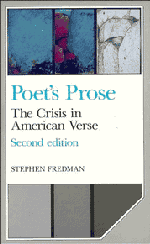Book contents
- Frontmatter
- Contents
- Preface to the second edition
- Preface to the first edition
- List of abbreviations
- Introduction: Prose and the American crisis of verse
- 1 The generative sentence: William Carlos Williams's Kora in Hell: Improvisations
- 2 “A life tracking itself”: Robert Creeley's Presences: A Test for Marisol
- 3 “He chose to include”: John Ashbery's Three Poems
- 4 The crisis at present: talk poems and the new poet's prose
- Notes
- Index
- Cambridge Studies in American Literature and Culture
2 - “A life tracking itself”: Robert Creeley's Presences: A Test for Marisol
Published online by Cambridge University Press: 04 April 2011
- Frontmatter
- Contents
- Preface to the second edition
- Preface to the first edition
- List of abbreviations
- Introduction: Prose and the American crisis of verse
- 1 The generative sentence: William Carlos Williams's Kora in Hell: Improvisations
- 2 “A life tracking itself”: Robert Creeley's Presences: A Test for Marisol
- 3 “He chose to include”: John Ashbery's Three Poems
- 4 The crisis at present: talk poems and the new poet's prose
- Notes
- Index
- Cambridge Studies in American Literature and Culture
Summary
A CONJECTURAL PROSE
Beyond humor, Tristram Shandy is the narrative of one man's attentions, of what they found to fasten on. That is a defensible comment – there is very clear writing in this book.
CreeleyRobert Creeley praises Tristram Shandy in the context of a review of John Hawkes's The Beetle Leg called “How To Write a Novel.” The digressive style of Tristram Shandy attracts American writers such as Creeley and Hawkes for a number of reasons “beyond humor” and satire; Sterne's writing shares the concern with disposing the relative claims of wholeness and completeness at both the narrative and the sentence levels. In American literature we find the digressive narrative in Thoreau, for example, who proposes in “Walking” a physical and intellectual method he calls “sauntering,” a ruminative, meditational stroll, that gives the walker a free rein, enabling one thereby to discover natural law. Narrative digression is also a natural counterpart to the generative sentence, where, as we have seen, grammar leads the writing through a succession of ideas, resisting the gravitational pull of the “complete thought.”
There is a second aspect of the digressive narrative found in Tristram Shandy that has especially captivated twentieth-century American writers.
- Type
- Chapter
- Information
- Poet's ProseThe Crisis in American Verse, pp. 57 - 100Publisher: Cambridge University PressPrint publication year: 1990



